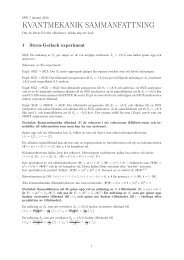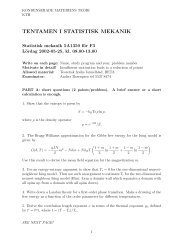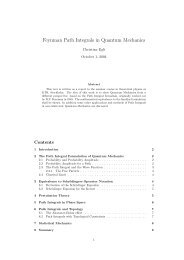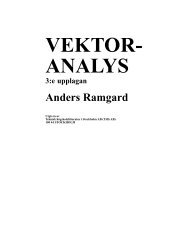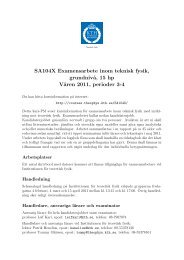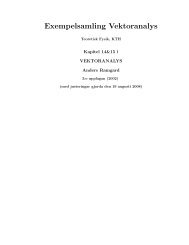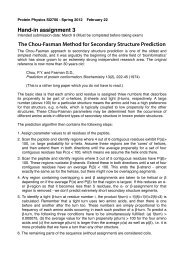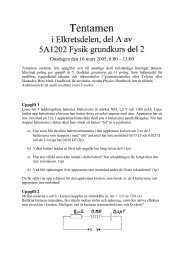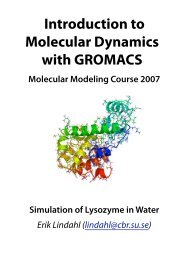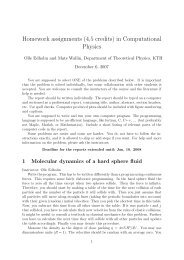[VAR]=Notes on variational calculus
[VAR]=Notes on variational calculus
[VAR]=Notes on variational calculus
Create successful ePaper yourself
Turn your PDF publications into a flip-book with our unique Google optimized e-Paper software.
under the c<strong>on</strong>straint<br />
for a given L 0 .<br />
L[y] =<br />
∫ x1<br />
There are many more examples, of course...<br />
x 0<br />
√<br />
1 + y′ (x) 2 dx = L 0 (6)<br />
2. Method of soluti<strong>on</strong><br />
As discussed, a variati<strong>on</strong>al problem amounts to extremizing some functi<strong>on</strong>al. The<br />
standard method to solve such a problem is to c<strong>on</strong>vert it into a ODE or PDE problem. It<br />
also can be useful to reformulate a given ODE or PDE problem as variati<strong>on</strong>al problem:<br />
this can provide a starting point for an approximate soluti<strong>on</strong>.<br />
2.1 Functi<strong>on</strong>als depending <strong>on</strong> <strong>on</strong>e functi<strong>on</strong> of <strong>on</strong>e variable.<br />
In this secti<strong>on</strong> I discuss in detail the simples kind of variati<strong>on</strong>al problems. All<br />
essential ideas behind variati<strong>on</strong>al <strong>calculus</strong> appear already here, and the generalizati<strong>on</strong> of<br />
these ideas to more complicated cases in the following secti<strong>on</strong>s is quite straightforward<br />
(I will be rather brief there).<br />
Problem 1 above is a (rather trivial) example of the following kind of problem:<br />
Problem A: Given a functi<strong>on</strong>al<br />
J[u] =<br />
∫ x1<br />
x 0<br />
F(u(x), u ′ (x), x)dx (7)<br />
where F = F(u, u ′ , x) is a C 2 functi<strong>on</strong> of three real variables. Find the functi<strong>on</strong>(s) u<br />
<strong>on</strong> the interval [x 0 , x 1 ] fixed at the end points, u(x i ) = y i for i = 0, 1, and extremizing<br />
this functi<strong>on</strong>al.<br />
To avoid c<strong>on</strong>fusi<strong>on</strong> I should make clear here that I slightly abuse notati<strong>on</strong> and use<br />
the symbols u and u ′ in two different meanings: firstly, in F(u, u ′ , x) as a symbols<br />
for the first and sec<strong>on</strong>d variable of the functi<strong>on</strong> F, and sec<strong>on</strong>dly, as symbol for the<br />
functi<strong>on</strong> u <strong>on</strong> [x 0 , x 1 ] and its derivative. This is not the same, and a pedant would have<br />
written F = F(r, p, x) and used different symbols. However, <strong>on</strong>ce <strong>on</strong>e has thought this<br />
through carefully there is no more need to make such distincti<strong>on</strong>s: as we will see, it<br />
is quite useful to be somewhat vague about what <strong>on</strong>e means by u and u ′ since this<br />
avoids lengthy notati<strong>on</strong>. However, I know that this “identifying u with u(x) and u ′<br />
with u ′ (x)” which is used in many physics texts (and here) can be quite c<strong>on</strong>fusing for<br />
beginners, and I hope my remarks here and below will help to avoid this c<strong>on</strong>fusi<strong>on</strong>.<br />
(Similar remarks apply to my discussi<strong>on</strong>s of other variati<strong>on</strong>al problems below: in these<br />
cases I will also abuse notati<strong>on</strong> in a similar manner without further comments.)<br />
Below I derive and (try to) explain the following important<br />
5


![[VAR]=Notes on variational calculus](https://img.yumpu.com/35639168/5/500x640/varnotes-on-variational-calculus.jpg)
